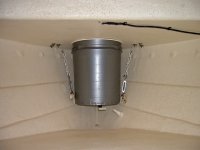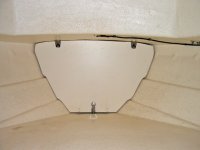Marco Flamingo
Active member
- Joined
- Jul 9, 2015
- Messages
- 1,170
- Reaction score
- 0
- C Dory Year
- 2004
- C Dory Model
- 16 Cruiser
- Vessel Name
- Limpet
After spending a lot of nights on the hook this summer, I've changed my ground tackle. My lightweight Danforth style Guardian anchor is now my backup. Reason being is that without a length of chain I had difficulty getting it to set. I would have liked to keep the weight out of the bow, but I went with the smallest Vulcan anchor (9#). It fits perfectly on the stock bow roller and is self launching.
I have also replaced my rode. I originally went with sinking line (basic leaded crab pot line) with a length of stainless steel wire spliced in for abrasion resistance. I really want to avoid any chain, as it won't work with my manual launching system. Chain is the go-to solution for most boats and I loved it on my big boats when I had a winch. But manually hauling in chain is different than pushing the winch button.
What I found out was that the leaded crab line gave negative buoyancy, but just barely. And the length of SS wire might be good for abrasion resistance, but it wasn't heavy enough to help set the anchor. Even with the Vulcan, I had to let out about 10:1 to get it to set and then usually bring some rode back in so that I could reduce swinging into the beach. When I got the anchor to set, I was concerned as to what it might do on the reverse tide. Light ground tackle makes for light sleeping.
My new setup is a leaded line that is generally used as the sink line on the bottom of a seine net or similar. Instead of a thin thread of lead inside of 5/16" polypro rope like a crab pot line, this has chunks of pencil lead inside of a 1/2" 8-plate rope. I had a big spool of it from another project and thought a long time about trying it. I don't remember the exact specs, but it's classified by pounds per fathom. My @140 feet of leaded anchor line weighs about 30#. It stores on a plastic reel intended to be used for large extension cords.
The anchor rode is spliced directly to a D shackle on the anchor. No abrasion resistance, so I'll have to stay away from coral heads. I think I can do that. And I'll have to inspect it regularly. Now I just have to see how it works. Pictures when I find my camera.
Mark
I have also replaced my rode. I originally went with sinking line (basic leaded crab pot line) with a length of stainless steel wire spliced in for abrasion resistance. I really want to avoid any chain, as it won't work with my manual launching system. Chain is the go-to solution for most boats and I loved it on my big boats when I had a winch. But manually hauling in chain is different than pushing the winch button.
What I found out was that the leaded crab line gave negative buoyancy, but just barely. And the length of SS wire might be good for abrasion resistance, but it wasn't heavy enough to help set the anchor. Even with the Vulcan, I had to let out about 10:1 to get it to set and then usually bring some rode back in so that I could reduce swinging into the beach. When I got the anchor to set, I was concerned as to what it might do on the reverse tide. Light ground tackle makes for light sleeping.
My new setup is a leaded line that is generally used as the sink line on the bottom of a seine net or similar. Instead of a thin thread of lead inside of 5/16" polypro rope like a crab pot line, this has chunks of pencil lead inside of a 1/2" 8-plate rope. I had a big spool of it from another project and thought a long time about trying it. I don't remember the exact specs, but it's classified by pounds per fathom. My @140 feet of leaded anchor line weighs about 30#. It stores on a plastic reel intended to be used for large extension cords.
The anchor rode is spliced directly to a D shackle on the anchor. No abrasion resistance, so I'll have to stay away from coral heads. I think I can do that. And I'll have to inspect it regularly. Now I just have to see how it works. Pictures when I find my camera.
Mark


